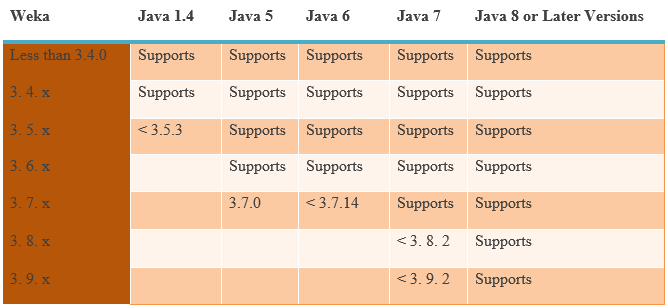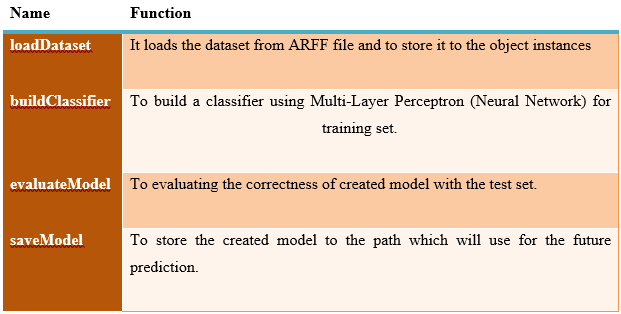Weka is abbreviated as Waikato Environment for Knowledge Analysis and it is also the name of a bird in New Zealand called Weka. Weka is an Open Source library for Machine-Learning. It is a Java-based version; it is one of the no-code tools which are resourceful and powerful. Weka in beginning developed and started in the year of 1997 and now it is used in various application areas, mainly it is used for educational intention and do researches. Essentially it can be used to implement the art of Machine Learning models which supports various file formats.
Start Your Free Software Development Course
Web development, programming languages, Software testing & others
What is weka java?
Weka is a group of Machine Learning algorithms for developing data mining tasks. It encloses tools for Clustering, Data Preparation, Regression, Classification, Visualization, and Association rule mining. Weka is a collected group of algorithms of Machine Learning for the Data Mining tasks. Those algorithms will be applied to the Dataset directly otherwise from the Java-Code.
In the earlier version, Weka was first and foremost designed as the tool to analyze the data from agricultural domains, but now it is a fully Java-based version (Weka 3), recently it is used for various application areas, specifically for the educational purpose and research-oriented.
How to use weka java?
By using Weka, we need to install weka based on your Operating System. Once downloading the archive to extract it you will get the jar file like weka.jar. It contains the entire class files required to developing an application like weka API and so on.
After the complete installation part, we need to include the jar as a classpath in our implementation. The classpath describes that the JDK regards the external class files in external libraries. While adding the classpath it is suggested to use – cp option of commands in JDK. When we work on any of the frameworks then the classpath can be included for the relevant manifest file.
Type of platform
Weka is an Open Source library for Machine-Learning technology. It is a Java-based version; it is one of the no-code tools which are resourceful and powerful. The precondition is that we need to have Java 8.0 installed in your machine. We can install Weka on any kind of platform by following such instructions as follows, after the completion of weka installation you need to include standard interfaces and data processing techniques. Let’s see the following techniques,
- Data Pre-Processing: Once loading the dataset, the Weka makes it possible to rapidly investigate its instances and attributes. In addition, there are various filtering techniques are available, let’s see one example – to convert the data into a numerical way to perform the feature selection to reduce the dimension in the dataset, like to speed up the timings and performance of training.
- Regression Algorithms and Classification: In the classification and regression algorithms there are a set of various algorithms like Decision Trees, Gaussian Naive Bayes, K-Nearest Neighbour, Linear Regression Variants, and Ensembles Techniques.
- Clustering: The Clustering technique is used in organizing to identify the essential categories of our data in an invalid way. Most of the examples algorithms make available with the weka collection are the K-Means Clustering and Expectation Maximisation.
- Data Visualisation: The data visualization technique is an integrated data visualization which promptly predicts the correlations between the represented machine learning patterns and features like K-Means Clustering and Decision Trees.
- Discovering Associations: The discovery association which discovers the basic rules in the dataset, in order to get easier identifiable patterns and also the connections involving various features.
Requirements for weka java
The basic requirement for weka java is that we have in any case Java 1.7 installed. To download and install the weka choose the latest version of weka for your system, it requires at least Java 1.7.
Let’s see the following which shows the minimum version of Java required to execute the particular version of Weka. The up-to-date releases of Weka need Java 8 or later. In order to avoid the improper scaling of Weka’s GUI (Graphical User Interfaces) in your Windows system, you have to make use of Java 9 pr later versions for the display with High Pixel Density (HiDPI).

Advantages
The advantages of Weka consist of the following things,
- We can at free availability under the GNU General Public License
- It’s easy to use because of its GUI (Graphical User Interface).
- It is portable because of the full implementation in Java Programming Language and it’s executed on any of the Modern Computing Platform.
- There is a wide-ranging of collected Data Pre-Processing and Modelling Techniques.
Model generator class in the example
Let’s see the model generator class, to generating a model we need to use Multi-Layer Perception called Neural Networks to categorize in iris 2D dataset. We can make use of the default value of the Neural Network Learning Process or we can set it manually through the setter methods.
There are several Model Generator Class, Lets see the following models as follows,

Conclusion
In this article we have come to known about the Weka, it is an influential tool. In recent times it is used for various application areas, specifically for educational purposes and research-oriented. Hope the article helps you to understand the base things in Weka.
The above is the detailed content of Weka in Java. For more information, please follow other related articles on the PHP Chinese website!

Hot AI Tools

Undress AI Tool
Undress images for free

Undresser.AI Undress
AI-powered app for creating realistic nude photos

AI Clothes Remover
Online AI tool for removing clothes from photos.

Clothoff.io
AI clothes remover

Video Face Swap
Swap faces in any video effortlessly with our completely free AI face swap tool!

Hot Article

Hot Tools

Notepad++7.3.1
Easy-to-use and free code editor

SublimeText3 Chinese version
Chinese version, very easy to use

Zend Studio 13.0.1
Powerful PHP integrated development environment

Dreamweaver CS6
Visual web development tools

SublimeText3 Mac version
God-level code editing software (SublimeText3)

Hot Topics
 Applying Semantic Structure with article, section, and aside in HTML
Jul 05, 2025 am 02:03 AM
Applying Semantic Structure with article, section, and aside in HTML
Jul 05, 2025 am 02:03 AM
The rational use of semantic tags in HTML can improve page structure clarity, accessibility and SEO effects. 1. Used for independent content blocks, such as blog posts or comments, it must be self-contained; 2. Used for classification related content, usually including titles, and is suitable for different modules of the page; 3. Used for auxiliary information related to the main content but not core, such as sidebar recommendations or author profiles. In actual development, labels should be combined and other, avoid excessive nesting, keep the structure simple, and verify the rationality of the structure through developer tools.
 The requested operation requires elevation Windows
Jul 04, 2025 am 02:58 AM
The requested operation requires elevation Windows
Jul 04, 2025 am 02:58 AM
When you encounter the prompt "This operation requires escalation of permissions", it means that you need administrator permissions to continue. Solutions include: 1. Right-click the "Run as Administrator" program or set the shortcut to always run as an administrator; 2. Check whether the current account is an administrator account, if not, switch or request administrator assistance; 3. Use administrator permissions to open a command prompt or PowerShell to execute relevant commands; 4. Bypass the restrictions by obtaining file ownership or modifying the registry when necessary, but such operations need to be cautious and fully understand the risks. Confirm permission identity and try the above methods usually solve the problem.
 Differences Between Callable and Runnable in Java
Jul 04, 2025 am 02:50 AM
Differences Between Callable and Runnable in Java
Jul 04, 2025 am 02:50 AM
There are three main differences between Callable and Runnable in Java. First, the callable method can return the result, suitable for tasks that need to return values, such as Callable; while the run() method of Runnable has no return value, suitable for tasks that do not need to return, such as logging. Second, Callable allows to throw checked exceptions to facilitate error transmission; while Runnable must handle exceptions internally. Third, Runnable can be directly passed to Thread or ExecutorService, while Callable can only be submitted to ExecutorService and returns the Future object to
 How Java ClassLoaders Work Internally
Jul 06, 2025 am 02:53 AM
How Java ClassLoaders Work Internally
Jul 06, 2025 am 02:53 AM
Java's class loading mechanism is implemented through ClassLoader, and its core workflow is divided into three stages: loading, linking and initialization. During the loading phase, ClassLoader dynamically reads the bytecode of the class and creates Class objects; links include verifying the correctness of the class, allocating memory to static variables, and parsing symbol references; initialization performs static code blocks and static variable assignments. Class loading adopts the parent delegation model, and prioritizes the parent class loader to find classes, and try Bootstrap, Extension, and ApplicationClassLoader in turn to ensure that the core class library is safe and avoids duplicate loading. Developers can customize ClassLoader, such as URLClassL
 Exploring Different Synchronization Mechanisms in Java
Jul 04, 2025 am 02:53 AM
Exploring Different Synchronization Mechanisms in Java
Jul 04, 2025 am 02:53 AM
Javaprovidesmultiplesynchronizationtoolsforthreadsafety.1.synchronizedblocksensuremutualexclusionbylockingmethodsorspecificcodesections.2.ReentrantLockoffersadvancedcontrol,includingtryLockandfairnesspolicies.3.Conditionvariablesallowthreadstowaitfor
 Handling Common Java Exceptions Effectively
Jul 05, 2025 am 02:35 AM
Handling Common Java Exceptions Effectively
Jul 05, 2025 am 02:35 AM
The key to Java exception handling is to distinguish between checked and unchecked exceptions and use try-catch, finally and logging reasonably. 1. Checked exceptions such as IOException need to be forced to handle, which is suitable for expected external problems; 2. Unchecked exceptions such as NullPointerException are usually caused by program logic errors and are runtime errors; 3. When catching exceptions, they should be specific and clear to avoid general capture of Exception; 4. It is recommended to use try-with-resources to automatically close resources to reduce manual cleaning of code; 5. In exception handling, detailed information should be recorded in combination with log frameworks to facilitate later
 Asynchronous Programming Techniques in Modern Java
Jul 07, 2025 am 02:24 AM
Asynchronous Programming Techniques in Modern Java
Jul 07, 2025 am 02:24 AM
Java supports asynchronous programming including the use of CompletableFuture, responsive streams (such as ProjectReactor), and virtual threads in Java19. 1.CompletableFuture improves code readability and maintenance through chain calls, and supports task orchestration and exception handling; 2. ProjectReactor provides Mono and Flux types to implement responsive programming, with backpressure mechanism and rich operators; 3. Virtual threads reduce concurrency costs, are suitable for I/O-intensive tasks, and are lighter and easier to expand than traditional platform threads. Each method has applicable scenarios, and appropriate tools should be selected according to your needs and mixed models should be avoided to maintain simplicity
 What is the purpose of the `static` keyword in Java?
Jul 05, 2025 am 02:36 AM
What is the purpose of the `static` keyword in Java?
Jul 05, 2025 am 02:36 AM
Static keywords are used in Java to create variables and methods that belong to the class itself, rather than instances of the class. 1. Static variables are shared by instances of all classes and are suitable for storing data shared by all objects, such as schoolName in the Student class. 2. Static methods belong to classes and do not depend on objects. They are often used in tool functions, such as Math.sqrt(), and can only access other static members. 3. Static code blocks are used to perform initialization operations when class loading, such as loading libraries or setting logs. 4. Static inner classes can be instantiated independently of the external class, but non-static members of the external class cannot be accessed. Rational use of static can effectively manage class-level resources and behaviors.






